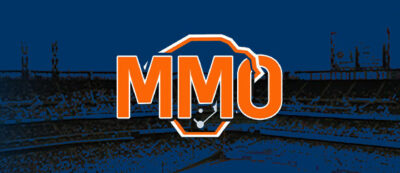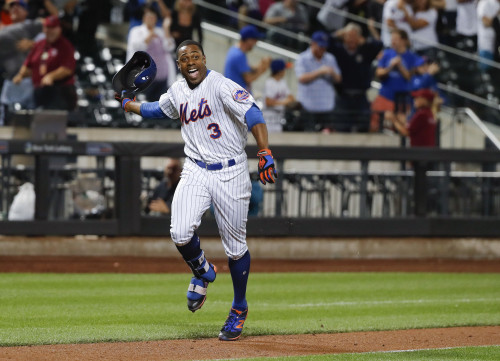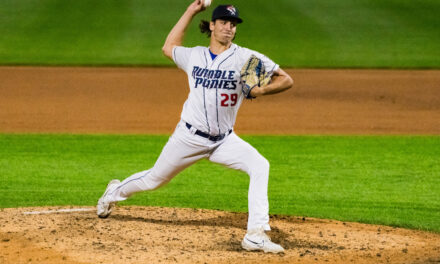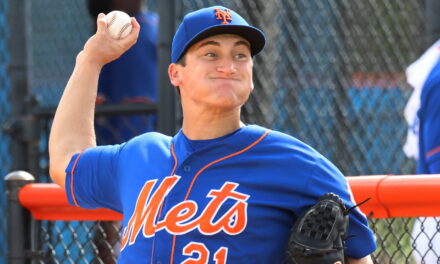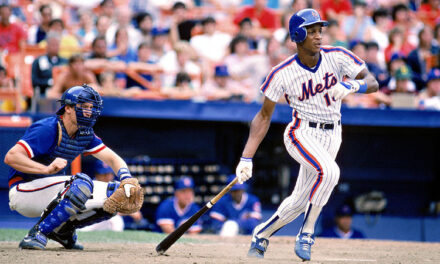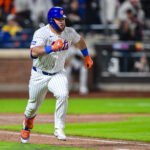In Major League Baseball history, only six players have recorded 90+ triples, 300+ home runs and 150+ stolen bases, showcasing a penchant for both power and speed: Willie Mays, Hank Aaron, George Brett, Andre Dawson, Steve Finley and Curtis Granderson.
Granderson, 42, was an easy player to root for, no matter what team he was on. As congenial as they come, the left-handed hitter posted a 47.2 fWAR for his sixteen-year major league career, and was a true ambassador for the sport on and off the field.
Selected in the third round of the 2002 MLB Draft by the Detroit Tigers out of the University of Illinois at Chicago, Granderson didn’t expect to make the majors. In fact, he believed that he would spend two or three years in the minors before getting released to pursue other interests, be it in sports marketing or teaching, like both of his parents.
Fast forward to 2007, in which Granderson became the first player since Willie Mays in 1957 to tally at least 20 doubles, 20 triples, 20 home runs and 20 stolen bases in a season. In his second full season in the majors, Granderson posted the fourth-highest fWAR among position players in ’07 with a 7.9 mark, and finished tenth in the M.V.P vote in the American League.
The affable Granderson made his way to the New York Mets following the 2013 season. After spending the previous four seasons across town with the New York Yankees, in which Granderson recorded back-to-back 40+ home run seasons in 2011-12, he inked a four-year, $60 million deal with the Mets in December 2013.
The ‘Grandy Man’ was incredibly durable with the Mets, playing in at least 150 games in each of his first three seasons with the club. Granderson’s best season came in 2015, in which he led the Mets in fWAR (5.3), games played (157) and hits (150), while second in home runs (26).
En route to the Mets’ first division title since 2006, Granderson posted an OPS of .898 in the second half of the ’15 season, with a 151 wRC+ (tied for 16th-highest among 123 hitters with a min. 250 plate appearances).
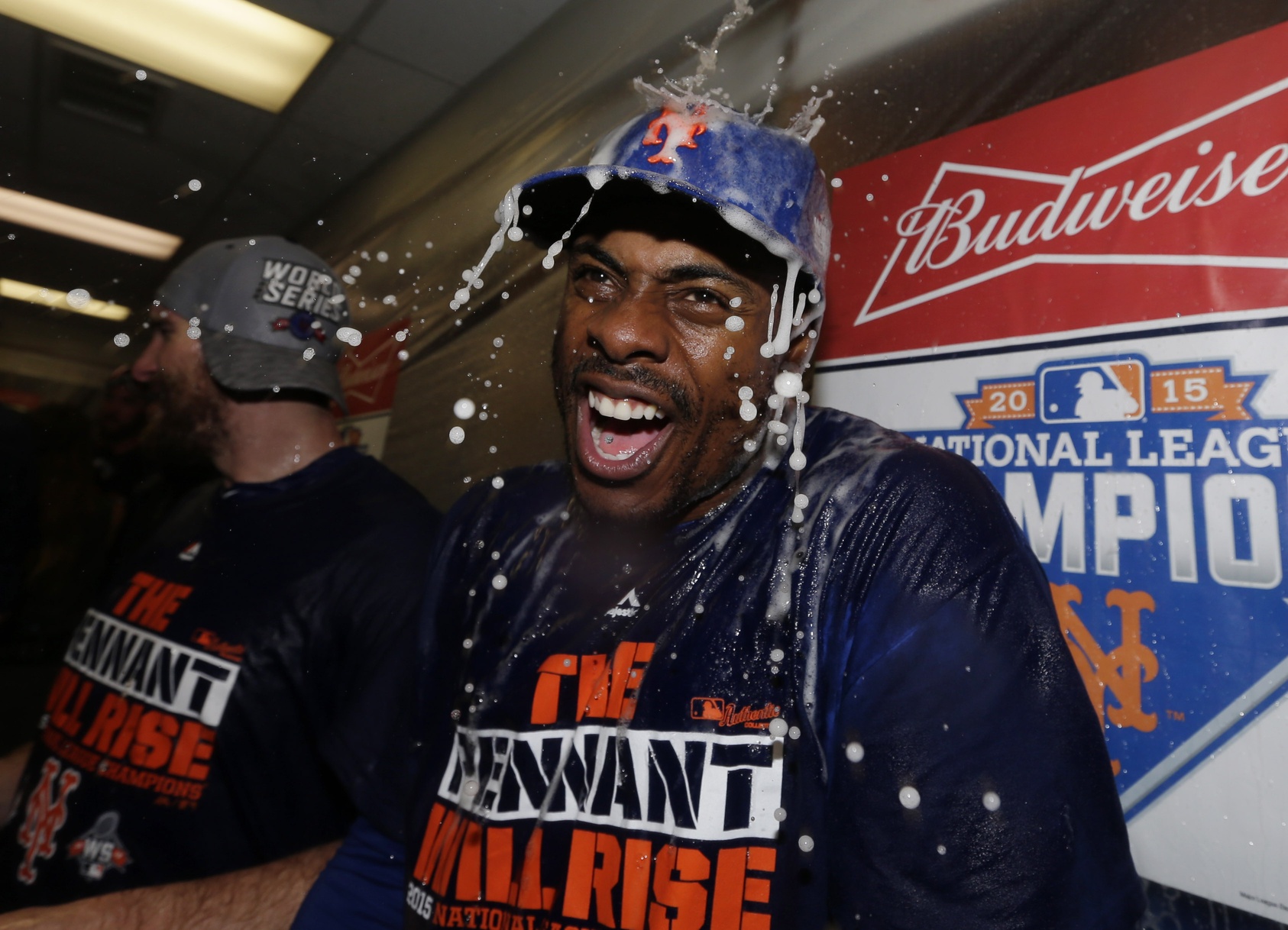
In 14 postseason games in ’15, Granderson produced an .866 OPS. His three home runs in the World Series tied Donn Clendenon (1969) for the most homers in a single Fall Classic in franchise history.
Following the 2019 season, Granderson announced his retirement. A Roberto Clemente Award recipient, a four-time Marvin Miller Man of the Year, a three-time All-Star and Silver Slugger winner, Granderson left an indelible mark on the game of baseball.
Beyond the recognition on the field, Granderson remains an incredible representative off it.
From his Grand Kids Foundation, founded in 2007 to provide educational and athletic opportunities to kids, to his broadcasting assignment for TBS’s Tuesday Night Baseball, to being the board chair of the Players Alliance, a nonprofit comprised of active and former players focused on building equitable systems in order to change the trajectory of diversity throughout baseball, Granderson has continued to keep busy and focus his time on important issues.
I had the privilege of interviewing Granderson over the phone, where he discussed juggling academics and athletics, his time with the Mets, friendship with Lucas Duda and his work outside of the game.
MMO: Both of your parents were educators. How did your parents have you balance academics and athletics growing up?
Granderson: They laid the groundwork that I had to get my schoolwork done first in order to participate in different activities. That was the priority.
A lot of people ask if I had to get straight A’s, or if I had to be on the honor roll. They didn’t need that, per se. As long as they spoke to a teacher and I put forth the effort required and there wasn’t, he didn’t turn this in or I know he can do more, then they were fine.
I got a D one time in Spanish II, and I was like, ‘Mom, Dad, you know it’s not me. This class is really bad. It’s the one class that doesn’t have air conditioning. It’s the summer and every other class in the foreign language hall is doing these cool cultural experiences.’
Our whole class had C’s and D’s. That was the only time I got a really bad grade and they were okay with it. It was getting your work done first, and then you could enjoy all the different activities.
MMO: Is it true you grew up an Atlanta Braves fan — even though you lived in Chicago — due to the timing of “Saved by the Bell” on television?
Granderson: It is! At that time, “Saved by the Bell” was on WGN, except for when the Cubs would play; they played a majority of day games. I’d be excited to come home and nope, the Cubs would be on. It was like, Man, I missed my show!
The timing of the Braves being so good led me to TBS, and I could watch baseball at night. A combination of “Saved by the Bell” not being on, the Braves being on at a time that made more sense for me and the Braves being good was a perfect recipe for me to become a Braves fan.
MMO: I have to test how big a fan you are. Did you also watch “Saved by the Bell: The College Years”?
Granderson: I did! The one thing I missed live was Zack and Kelly’s wedding. I forgot why I missed that, but I ended up seeing it.
Even before that, I watched the beginning when it was “Good Morning, Miss Bliss,” before it became “Saved by the Bell.” I loved every bit of it!
MMO: Can you tell me what the phrase ‘Don’t Think, Have Fun’ means to you?
Granderson: It was coined in combination with my head coach, Mike Dee, from the University of Illinois, Chicago. He was in his second year as head coach of baseball, which was my first year there.
One of the things he said to me early on in my college career was, “You’re very analytical. You can think with the best of them, but I don’t want you to overthink it. Just trust your ability. Go out there and have fun.”
That stuck with me because I would have a day where I would do something successful and still try to find something. I would nitpick a bit. He said, “No, trust what you’ve been doing and go out there and do it.”
From that moment, I started writing it underneath my hat as a constant reminder because you’re constantly taking your hat off throughout the game, so you can look at it. That was a good spot for me to have it.
I used it all the way through my career because the game is hard and challenging enough. Why add more? It’s supposed to be the same game that you were playing when you first started and fell in love with it. As long as you can do that, you’ll have fun doing it. That’s when you tend to be at your best.
I always try to relay that message to younger players: As long as you can put forth the work, then you can trust it. When you put forth the work, you get the results. When you get the results, you have fun. And when you’re having fun, you want to perform.
It all goes in cycle, right? That’s when you end up just enjoying it. It was a good reminder for me.
MMO: You mentioned being analytical. Were you someone who embraced the metrics throughout your playing career?
Granderson: I feel like it came out of the storm, but then there was no one there to explain it to you. Either up on the scoreboard or you have a meeting where they would say that you need to improve in a certain stat. But there wasn’t any follow up in terms of this is why it’s important. If you do these things, this will increase these numbers and therefore, hopefully results in this.
I feel like that part has been, and still kind of is, missing a bit. I’ll see stats pop up and I have no idea what it means. Even when I look at it and go, Okay, I know a bigger number is better, but how do I get a bigger number? What does that mean once I do get a bigger number? Am I actually doing something better than something else?
WAR was a very popular one right away towards the middle part of my career. I would always ask people how WAR is defined defensively. No one would give me an answer, and I still don’t know how to define it defensively. There are also two or three different WARs, so which one is the most accurate? Then there’s the wRC+ and OPS+, and you start adding these plus symbols on different things.
It’s very unique because if you look at some of the analytic numbers that have come out, they’ve been able to backtrack it to players that played way before this time and throw it on them. And that’s an interesting question. Just thinking defensively, do we know for players that played when there was no TV and all that stuff the range they had? All we know is putouts, attempts and errors. So how do we accurately quantify it?
This isn’t me saying I’m against it; I definitely think there’s a place for it. I just think there needs to be a better job of explaining it, especially to the younger players.
For the longest it was, if I got more hits, my average goes up. Okay, I know that. If I walk, my on-base goes up; if I don’t make an error, my fielding percentage stays higher. I knew those different things. Ultimately, those things would lead me to being a better player, helping our team get a chance to win, or once you start playing professionally, start to make more money.
MMO: You hit the free agent market for the first time after the 2013 season. What was going through that process like, and what made you ultimately sign with the Mets?
Granderson: It was unique because I was finally getting the chance to get close to that point. I had just come off of a solid 2011-2012. I was like, If everything continues to stay in place in 2013, the offseason could be very exciting.
I got hurt twice; I get hit in the hands in the first at-bat of spring training, and then I came back and I got hit eight days later in the hand and missed more time. I only played a fraction of a season (61 games).
That changed a couple of things for me in terms of the outfielders who were going to be free agents. I think it was Jacoby Ellsbury, Shin-Soo Choo, myself; I think we were the top three. My stock fell because I was hurt.
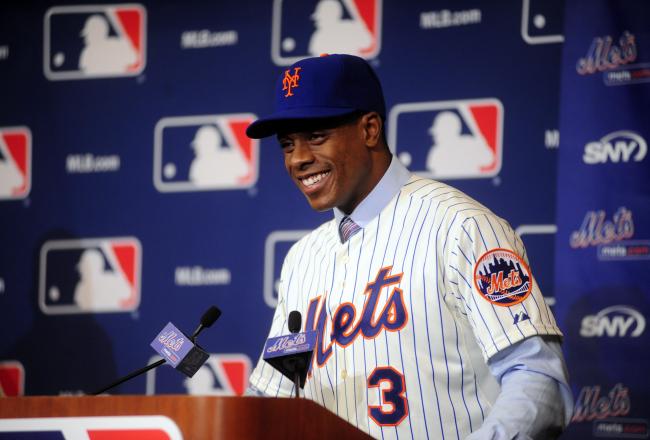
We’re going through it and the Mets reached out, and I started talking about a couple of different things. What’s interesting in the baseball landscape, the American League and the National League, up until this year, even with interleague play, you don’t really know what’s going on with the other side because you don’t play them nearly as much. Yes, you have your natural rivals, so we had the Subway Series. Whether it was a four-game or six-game series, in the grand scheme of 162, you didn’t really focus on them too much and vice versa.
I didn’t know a ton about the Mets. I played the Mets in interleague in ’07 with the Tigers, and in the Subway Series during my time with the Yankees. Over the course of 2004, when I debuted, to 2013, I only played against them four times and maybe in spring training.
I played against David Wright in the minor leagues, so I knew he was there. After that, it was like, I really don’t know much about them. I met with Sandy Alderson and we got a chance to chat and talk about things. The conversation started moving forward and I was like, You know what? I’ve been in New York for four years. I’m very familiar with it when we play in the Subway Series; I would just drive to Citi Field. I’m used to getting to and from and it’s not too complicated. I think this could be a good fit.
Everything kind of aligned that way and the Mets became my first free agent home.
MMO: Something I’ll always remember during your time with the Mets is your friendship with Lucas Duda. The wefollowlucasduda Instagram account was amazing. Can you talk about your relationship with Duda, and how that account came about?
Granderson: We were locker mates. With him being a left-handed hitter, we would talk a lot in the cage or during the game. One of the things I always try to communicate to younger players is look at the other players in the lineup that are similar to you, whether you’re a right-handed batter, switch hitter or a left-handed batter. There’s a good chance they’re (the pitchers) probably doing very similar things to that batter that they are to you. That could help you throughout the course of a game.
Sure enough, with Duda and I, we would watch each other and talk about things. What do you see? What do you feel? What’s going on? That’s how our relationship started.
Duda’s very quiet, he stays to himself and doesn’t say too much. At this time, I think Instagram, in terms of being viral, just started to become a big thing. The number of players who would enter a team that already had social media or the number of players that were starting to jump on was skyrocketing. But there were still a lot of them who swore they would never get it.
Daniel Muno, John Mayberry and myself were like, let’s many an account for Duda. That’s how it started. It wasn’t even the plan to grow followers, it was to make one for him because he didn’t have it and didn’t want one. We became this invasive paparazzi crew that would follow him and antagonize him.
I think it was helpful because it kept him loose and relaxed because he can overthink with the best of them, just like me. We got to keep the game fun and do all these different things. It’s amazing how quickly the followers jumped. We got to 100,000 followers in a matter of a couple of months! And then people wanted more.
I think it’s (the account) still out there, but I don’t think anything has been posted recently. It’s funny how that came to be. But it helped not only him but the clubhouse stay loose because other players started trying to sneak pictures of him and give them to me and give me a chance to post.
I did one that was really good and he begged me not to post it. And I never did it. I caught him one time in the bathroom, and he was in the stall. I went into the stall next to him. I stood on top of the toilet and went over the top and took a picture of him. [Laughs.] I was ready to post it but he was like, “No, please don’t post it!” That’s one that was deleted and no one got a chance to see it.
MMO: I love how this became a team effort.
Granderson: It was amazing. Everyone was like, “Oh, I got this!” And then I’d say, ‘The quality isn’t good.’
I became a photo editor and social media person where I’d say, ‘That’s not good enough. I need five seconds of video. I need this, I need that.’ My team was out there going to work.
MMO: Only two Mets in franchise history have hit three homers in a single World Series: Donn Clendenon in 1969, and you in 2015. What memories stand out from that Fall Classic?
Granderson: It was fun to see Citi Field rocking. It was exciting that it happened my second year there. Although I had signed there, I knew there wasn’t a lot of anticipation for us to be as good as we were that fast.
Here we are on the biggest stage, the final two teams standing, and we have a chance to do something that hadn’t been done in a very long time. The energy was through the roof! It was exciting and loud. If we just would’ve won Game One… there’s a number of factors that played into that. Alex Gordon extending and putting the game into extra innings and then ultimately winning the game, but we forget how that game started: they had the inside-the-park home run (Alcides Escobar), and then we came back and took the lead.
If we win that one, I’d definitely give the Royals Game Two because they just outplayed us. Now we come back to Citi Field being tied one-one versus being down zero to two. It’s a different mindset.
It’s the same thing with my hat: don’t think, have fun. I had been in the postseason and the World Series in ’06, and I put way too much pressure on myself. I made it a point to say, ‘I don’t care what happens, I’m going to have as much fun out there as possible.’
I feel like that let me go out there and do some of the things you quoted statistically. When we were down three games to one before our last game at Citi Field, Kevin Long, our hitting coach, called a hitter’s meeting. We went in the cage and he wanted to see where everyone was at and what we were thinking. I sat there and said, ‘Isn’t this fun? We have a chance to do something that’s only been done a couple of times. Let’s go out there and have a ton of fun and just see what happens.’
In that game, I led off with another home run. Unfortunately, we ended up not getting the win to extend the Series. It was still fun! Of course, we wanted to win it which would’ve been even more fun. I enjoyed every moment of it. You don’t get a chance to be there often, so you have to take advantage of it. I made sure I did.
MMO: In the 2016 Wild Card Game, you made one of the best catches I’ve ever seen in center in the top of the sixth. You covered a ton of ground running back and somehow kept the trajectory of the ball in your view. What are your memories from that play?
Granderson: Hitting the wall and just being able to get up. It’s funny, prior to that, I talked about how loud the place can be, but there’s times where I don’t hear anything. I’m going back for a ball and don’t hear anything; hit a home run, don’t hear anything; run for a triple, don’t hear anything. I just go deaf.
Very similar to that situation, I just remember thinking, He got this one over my head. One of the things I’ve always enjoyed as a center fielder was going back on the ball. I feel like that was my strength versus coming in. When given the opportunity, I tried to play as shallow as I could because that was my strength.
Sure enough, here’s a ball over my head and now it’s time for me to go back. I could sense the wall was coming on, and I was like, This is going to hurt. But it’s zero-zero and if I don’t try this, it’s going to bounce off the wall and going to be at least a double, maybe a triple. That could be the game-winning run, so let me go.
When I hit, I was like, Okay, my shoulder feels fine, wrist feels fine, I can breathe. I finally started to hear the crowd at that point as we start to come off the field. But prior to that, I was like, Let me get us to the playoffs. If I get hurt on it, this is the one chance to do it to keep us in the ballgame.
But it wasn’t enough. We didn’t have enough star power. Even if we win that game, I don’t know if we had enough at that point of the year in 2016 to keep going further. A lot of our pitching was hurt and we were scraping by and doing enough. At that point, I think we would have been exposed if we were to move forward.
MMO: Along with your playing career, you were also a big leader with the Players Association, and won four Marvin Miller Man of the Year Awards. Can you talk about how important it was to be involved with the MLBPA?
Granderson: I kind of got pushed into that in 2006, my first full year with the Tigers. It was an election year for the team, and every two years I think it is, the team votes for their main team rep and alternate rep.
So it’s my first full year in the big leagues and someone recommended me, and then they seconded me. I’m looking around thinking, What does that mean? All of a sudden, I’m in this position. I thought, If I’m in this position, let me figure out what I can do.
At the end of the season, I went to my first union meeting in the winter. At the time, the head of the players’ union was Michael Weiner, and I had no idea what was being talked about. It was the first time I heard words like collusion, arbitration, all these different things. I was just thinking, Let me ask some questions and not look too odd.
I started going year after year after year and started understanding a bit more. I started understanding the importance of asking more questions while also being able to take that information and give it back to my teammates. Or, if someone called and had a question, I can try to break it down for them. If I didn’t know the answer, I can point them in the right direction to get the feedback.
I pride myself on that because you have fun in this game, you enjoy it, get into it, and then there’s a lot of the business of the game where again, you just don’t know. We talked about the statistical side and that stuff’s not really explained to you, well, same thing with your playing career.
I had this conversation with one of the staff members at Turner. I’m talking to Jimmy Rollins and I said, ‘The Padres just DFA’d Nelson Cruz.’ One of the staff members went, “What does that mean?” And again, not saying that the staff member is supposed to know that, but I think most people don’t know what that means. And what that means for you and your career or what arbitration means or what exactly free agency means or what options mean.
You see a player and get mad about why he got sent down. Why did my favorite player get sent down? We have these emotional responses, but we don’t understand the reasoning behind it. That’s where understanding what the union is for and what has been collectively bargained is important.
I have some former teammates that are now in real estate and they’re in Chicago. We have two teams here, so a lot of players have either signed here, were traded here or started a new career here, and they’re looking for a place. I’ll try to connect them, and this is someone who played pro ball and is constantly asking me, “What happens if a player gets sent down? What happens if a player gets traded but they’re in a lease?”
That language is in the Collective Bargaining Agreement. It’s amazing how few people know what that stuff means. I took pride in gathering the information and passing that along.
To be acknowledged with the Marvin Miller Man of the Year Award is just a sign of what the players and the game thought of me from that standpoint. I appreciate them because they’re the ones voting for it. I always tried to do my best to improve the scenarios for the players that were there, and provide as much information as I could.
MMO: Talk to me about your foundation. When did you initially start it, and what is the mission?
Granderson: In 2007, I’m in Detroit, and I got approached about starting a foundation. I heard about foundations but again, it’s one of those things that I didn’t know what all went into it. They told me to find something I like and go for it. I said, ‘Education, that’s important.’ I remember people asking, why education? And I said, ‘That’s important to me.’
This is when the Wounded Warrior Project was going on, a lot of the military focused initiatives were front and center. I didn’t have a passion for that like I do education. So I went for it.
The name Grand Kids plays off my last name and kids being in school. The education side of it was started, and obviously, using baseball as a vehicle because that’s what I was involved in that I could hopefully use as a character. Like, here’s a baseball player telling me that school is fun and important. Let me listen to that player tell me that stuff.
At the time in Detroit, the high school graduation rate was at fifty percent. That stood out to me and I wanted to do something around that. We started with education and baseball, trying to get kids active. I was able to join Michelle Obama’s Let’s Move campaign to help fight childhood obesity. We got kids moving around and started all these different initiatives.
Fast forward to where we are now, we have food and insecure issues that we tackle here in my hometown of Chicago. I’ve done that in a bunch of different places with the food bank from New York and for one of the hurricanes in Houston. We were able to help with No Kid Hungry, which has national reach.
The good thing about playing for seven different teams is I got a chance to be in all of these different areas, including Canada. I realized that even though I might not be there full-time, I could still do something and not physically have to be there. That’s kind of how Grand Kids has evolved.
It’s amazing to say that it’s been going on for 15+ years. Who knows what the future is going to look like. As long as we continue to help out in some form or fashion and give kids an opportunity, that’s what I’m all about.
MMO: The Players Alliance was formed in the wake of the horrific killing of George Floyd in 2020, and is aimed to help build Black participation in baseball. Can you talk about your role in the Players Alliance, and some of the work the nonprofit does to help spur participation?
Granderson: I became the board chair and timing and I guess my position in the game aligned pretty well from that. I just retired, so I was still very much connected to the active players. C.C. Sabathia just retired, he’s our vice president. And then Edwin Jackson is our founding board chair. We had a good connection to the current players and the up-and-coming players. We were also connected to some of the older veteran players, players that had taken us under their wing like Dmitri Young, Ken Griffey Jr., Ellis Burks, to name a few.
It was a good bridge because it was a conversation that had already started 18 years ago, 30 years ago, but now we were able to bring it together because there was nothing going on at that time. Baseball wasn’t happening. Covid was happening and the George Floyd situation happened. Most people were just at home and able to be connected to this new and exciting thing that not many people knew about via Zoom.
For example, in 2008, I think it was, there were about 40 of us that all met in New York at the time. Frank Robinson was there, Tony Clark, C.C., Dontrelle Willis, Dmitri Young, a bunch of players. We had talked about very similar things to what the Players Alliance had become. I know players and generations before with Dave Winfield and all those players back then talked about it too, but life was happening. Let’s get together next year. Let’s get together this time next year. I can’t, I’m busy, I thought I had this. I’m injured. I’m free.
The timing of 2020, there was nowhere to go. We wanted to do more than just, if you remember at that time, everything was about, let’s take a stance on social media and post an orange square, a black square. I was like, This isn’t enough. We’ve got to do a little more than that. We’ve been talking about this, let’s see what we can do.
We’ve been trying to identify what have been some of the causes of why Black participation has gone down so much at the pro level, the college level and in the front office. We’re starting to realize that poverty has been one of the biggest barriers, or the lack of ability to afford certain things in this space. It’s not just the Black issue. It started and was founded by Black players, but this has affected so many different players.
When you look at the number of kids that play baseball up until the age of 12, the numbers are high here in the U.S. The most recent stat I saw was anywhere between two and three million kids play. But as soon as you jump into 13 and 14, you lose about one-to-two million kids. As of 2021, this was by “Sports and Fitness Industry Associations,” the baseball participation was at 3.67 million players ages six to twelve. Between the ages of 13 and 17, that number drops to 1.9 million.
You start looking and ask, why is there such a big drop? First, people look at the field finally gets bigger and the failure rate starts to go up a bit. Okay, that’s part of it. But at the same time, this is where travel ball becomes such a big thing. I’ve seen travel ball as young as eight years old, which doesn’t make any sense to me. At the same time, when it can start to make sense is when you get to 13U, or 14U, or 15U or 16U, I think there is space for it there. But the risk of cost associated with it, now you’ve alienated a lot of kids, especially kids that just want to play.
There is a family that I’ve grown up with where they communicate with me about their sons playing. They said, “We’re at a point now where we’re thinking about getting a motor home because all these hotels we constantly have to go to. It might be more affordable for us to go ahead and have this motor home. At least we don’t have to pay for all these different hotel rooms.’
Times have changed where you don’t just send your kids out, it’s a whole family gathering. So this is multiple rooms and multiple weekends. We’re trying to address those barriers with the Players Alliance by making accessibility affordable, especially if kids are being carded, scouted or recruited. And the only thing that’s keeping them from going is cost. Let’s try to find some workaround to do that. Once you start to get more of these players into that wheelhouse of playing more, now there’s more exposure, more recruitment. There’s more possibility to go on to the next level, whatever that happens to be.
The same thing moving into the education space, looking at opportunities to define whether it’s internships, entry-level jobs. It’s different spaces like that to provide opportunities, not handouts, just more opportunities because there is more demand.
I think that gets mixed up when people say there’s no interest. I think there’s definitely interest, but at the same time, you have to make a decision: can I afford this? If the answer is no, then I have to shift what it is I want to do, not because I’m not interested. I just can’t afford it.
MMO: When you look back on your career, what are you most proud of?
Granderson: The thing I’m most proud of is that I had fun out there, and it’s amazing that I got a chance to play as long as I did.
I never imagined that when I got drafted in 2002, I honestly thought and told people this, that I would play for two-to-three years in the minor leagues and get released. Then I would put my college degree to work in a number of different things, whether it be sports marketing because I was a marketing and management major, or follow what my parents and sister did and teach. I wanted to teach at the college level, I didn’t want to teach at the high school or grade school level.
What’s crazy is I played in 2002, played well, make the All-Star team. I played well in 2003, made the All-Star team. This is my second year of pro ball and I’m just hating life. I didn’t like where I was at in Lakeland, Florida, and the Florida State League.
I always tell people that the Major Leagues is the hardest, but the Florida State League is the second hardest. It’s hot, the stadiums are so big, there are no fans because who wants to sit out in a game where it’s a 95 degrees plus humidity. There are a couple of teams that draw, but Lakeland didn’t at that time. I think we were averaging two-to-three hundred fans a game at a stadium that holds 7,000!
All of my friends are in Chicago and going and doing all these things that sounded exciting. I was ready to be done. I got to the end of that season, I came back and I was able to finish and graduate with my college class, and then the next year I got called to the big leagues. It’s just crazy to think about in two or three years I’d be done, and I almost quit at the two-year mark, and then by the three-year mark I had made my Major League debut. I thought, Since I’m here, let’s see what happens.
It’s really cool to be a part of this baseball fraternity. To have done it and get a chance to talk to different people about it, and try to help anywhere I can on the field or off it is great.
Follow Curtis Granderson on Twitter, @cgrand3
